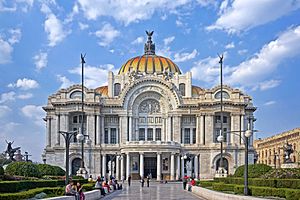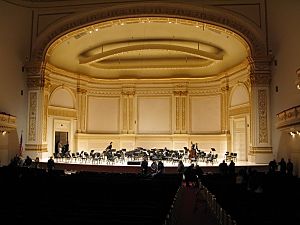Nestor Mesta Chayres facts for kids
Quick facts for kids
Néstor Mesta Cháyres
|
|
|---|---|
| Also known as | Nestor Chaires |
| Born | February 26, 1908 Ciudad Lerdo, |
| Died | June 29, 1971 (aged 63) Mexico City, Mexico |
| Genres | Opera, Bolero, Vocalist |
| Occupation(s) | Lyric Tenor |
| Years active | 1929–1970 |
Néstor Mesta Cháyres (also known as Nestor Chaires) was a famous singer from Mexico. He was born in Ciudad Lerdo on February 26, 1908, and passed away in Mexico City on June 29, 1971. He was a talented tenor, which means he had a high male singing voice. Néstor was well-known for singing Spanish songs, boleros (a type of slow-tempo Latin music), and romantic Mexican music all around the world. People especially loved his performances of songs by Agustín Lara and María Grever. He was even called "El Gitano de México," which means "The Gypsy of Mexico."
Contents
Early Life and Training
Néstor Mesta Cháyres was born in Lerdo, Mexico. His parents were Florentino Mesta and Juana Cháyres. He had six brothers and sisters. Néstor started learning music from a local teacher and a church organist when he was very young. Even as a child, he showed great promise as an opera singer. He would even sing along to recordings of famous opera songs.
While in high school, Néstor's amazing singing talent won him several awards. After his father passed away in 1925, he received a scholarship. This allowed him to study at the National Conservatory of Music in Mexico City. There, he learned about music theory, harmony, and voice from Lambert Castañeros, a singer who had performed in Italy.
Starting His Career
Néstor's professional singing career began in 1929 in Mexico City. He performed songs by Jorge del Moral and Agustín Lara at the Bolivár Amphitheater. Soon, he became very popular on the radio station X.E.B. in Mexico City, where he sang for four years.
In 1933, Néstor went on a concert tour with pianist Jorge del Moral to Havana, Cuba. He performed in many theaters and even sang for the President of Cuba three times during his two-month visit. After returning to Mexico City in 1934, he recorded several songs, including "Morena."
By the early 1940s, Néstor Cháyres was very famous across Mexico. In 1943, he performed with the Symphony Orchestra of Mexico at the beautiful Palace of Fine Arts in Mexico City. This big performance led to his debut in New York City.
International Success
Néstor first sang in New York City on the WABC radio station. He performed with the famous conductor Andre Kostelanetz and later with the Philadelphia Orchestra. Because he was such a talented opera singer, the CBS network invited him to perform for a special Easter Sunday broadcast. This show was overseen by the U.S. Department of State and featured the contralto Tona la Negra and the Mexican Symphony Orchestra. In the early 1940s, he also often performed at the Havana Madrid night club in New York, where critics praised him.
In 1943, Cháyres joined the Columbia Broadcasting System (CBS Radio). He was a main singer on the radio show Viva América. He worked with musical director Alfredo Antonini, accordion player John Serry Sr., and singer Manolita Arriola. Néstor continued to work with Antonini on live radio shows for Voice of America and the Department of State. These performances were also broadcast to American soldiers during World War II. They helped introduce Latin American music and the Mexican bolero to many people in the United States.
During this time, Néstor also recorded several boleros with Antonini and his orchestra for Decca Records. These included "Noche de Ronda" and "Granada." His recordings for RCA Victor in North and South America featured collaborations with other orchestras.
Néstor also performed regularly on the NBC radio network. He gave his first concert at the historic Town Hall in New York City in 1945 and returned three years later. In 1946, he performed again with Alfredo Antonini and the New York Philharmonic at Carnegie Hall for a special "Night of the Americas" concert.
These achievements led to many international concerts. In 1946, he performed with the Montreal Philharmonic Orchestra in Canada. He also toured South America, singing in Peru, Colombia, Venezuela, Chile, and Argentina. In 1947, he returned to Mexico to perform for President Miguel Alemán Valdés. He also sang at a reception for President Aleman at the Waldorf-Astoria Hotel in New York City.
In 1949, he joined the Chicago Opera House and toured Europe. He performed in France, Sweden, Holland, Norway, Denmark, England, and Spain. During this time, he was managed by the famous impresario Sol Hurok. In Madrid, he received great praise for his performance of the Seven Songs by Manuel de Falla. His last tour in the United States and Canada was in 1950. After returning to Mexico City, he married Peggy Satanon, who had first seen him perform at the Palace of Fine Arts.
Later Career and Legacy
In 1951, Néstor's singing career was put on hold. His mother tragically passed away in a car accident. Cháyres stopped performing concerts for over ten years. However, he did appear in the movie Cuando me vaya in 1954. In this film, he worked with actors like Libertad Lamarque and other singers such as Juan Arvizu and Alfonso Ortiz Tirado. This movie was a biography about the Mexican songwriter María Grever. It won two Ariel Awards in Mexico in 1955.
Néstor returned to television in 1968 for an appearance on the Paco Malgesto Hour. In 1969, he was on The Golden Hour of the W. His final television appearance was in 1970 on the show 24 Hours.
Performance Style
Critics from Billboard magazine praised Néstor Mesta Cháyres for his powerful and exciting performances. They noted his warm and tender singing style. Critics also mentioned his beautiful, full tenor voice. He was known for singing Mexican-gypsy folk songs with great fire and passion. His strong voice and wide vocal range could even be heard outside the theater. His singing often moved his audiences to tears.
Néstor Mesta Cháyres' performances of songs like "Murcia," "Toledo," and "Granada" by Agustín Lara earned him the nickname "El Gitano de Mexico" ("The Gypsy of Mexico"). He was often compared to other great tenors of his time, such as Juan Arvizu and Alfonso Ortiz Tirado.
Death
Néstor Mesta Cháyres passed away in 1971 in Mexico City. He was 63 years old and suffered a heart attack. He left behind many recordings of songs by Agustín Lara and María Grever.
Music Recordings
Albums
- Nestor Chaires - RCA de Venezuela - Néstor Cháyres performing in Caracas, Venezuela (around 1965).
- Nestor Chayres Canta - SMC-Proarte - Néstor Cháyres with the Alfredo Mendez Orchestra singing songs by Agustín Lara (around 1960s).
- Nestor Chayres - Romantic Songs of Latin America - Decca Records (1947, 1950). This album featured Néstor Cháyres with the Alfredo Antonini Orchestra.
- Seven Spanish Folk Songs - Kingsway - Néstor Cháyres with pianist Fritz Kramer performing music by Manuel de Falla (around 1950s).
Singles
- Alma Mia - RCA Victor - Néstor Chayres and the Orquesta de Henri Rene perform a song by Maria Grever.
- Buenas Noches Mi Amor - Néstor Cháyres and El Trio del Mar perform this song.
- Cara Piccina - Victor - Néstor Chayres and orchestra perform this song.
- Cuando Vuelva A Tu Lado - Néstor Mesta Cháyres performs this song by María Grever.
- El Relicario - Decca - Nestor Chayres and the Alfredo Antonini Orchestra perform the song by Jose Padilla Sanches.
- Gitanillo - Victor - Nestor Chayres performs this Paso Doble song (1949).
- Granada - Decca - Néstor Cháyres and the Alfredo Antonini Orchestra perform this song by Agustín Lara (1946).
- Hoy No Quisiera Vivir - Victor - Nestor Chayres and La Orquesta de La Radio Caracas perform this song.
- La Guapa - RCA Victor - Nestor Chayres and Orquesta Gonzalo Cervera perform a paso doble.
- La Morena De Me Copla - Decca - Nestor Chayres and the Alfredo Antonini Orchestra perform this song.
- Lamento Gitano - Decca - Nestor Chayres and the Alfredo Antonini Orchestra.
- Libreme Dios - Victor - Nestor Chayres performs this bolero (1949).
- Macarenas - RCA Victor - Nestor Chayres and the Vier Fidazzini Orchestra performing this bolero.
- Manolete - RCA Victor - Néstor Cháyres and Orcehstra Radio Caracas perform this song (Paso Doble) (around 1940s).
- Mucho Mas - Victor - Nestor Chayres performs this rumba bolero by María Grever (1949).
- Ni de Día, Ni de Noche - Barcelona Company of Gramophone Odeon - Néstor Cháyres performs song by María Grever (1950).
- No Espero Nada De Ti - Victor - Nestor Chayres sings this beguine by Maria Grever.
- No Te Vayas - Victor - Nestor Chayres performs this ballad with the Radio Caracas Orchestra (1948).
- Noche de Mar - Barcelona Company of Gramophone Odeon - Néstor Cháyres performs song by José Reyna (1950).
- Noche de Ronda - Decca - Néstor Cháyres and the Alfredo Antonini Orchestra perform this song by Agustín Lara (1946).
- Oracion Caribe - Decca - Nestor Chayres and the Alfredo Antonini Orchestra perform this song by Agustín Lara.
- Pobre Corazon - Victor - Nestor Chayres performs this bolero with the Radio Caracas Orchestra (1948).
- Por Eco Si Te Digo - Victor - Nestor Chayres performs this bolero with the Radio Caracas Orchestra (1948).
- Por Eso Si Te Digo - Victor - Nestor Chayres and La Orquesta de La Radio Caracas perform this song.
- Porque Te Quiero - RCA Victor - Nestor Chayres and La Orquesta Gonzalo Cervera perform this paso doble.
- Princesita - RCA Victor - Néstor Cháyres and Isidor Handler Orchestra perform this song (1947).
- Qué Me Importa - Barcelona Company of Gramophone Odeon - Néstor Cháyres performs this song (1949).
- Rayito De Luna - RCA Victor - Nestor Chayres and Orquesta De Henri Rene perform this song.
- Rocio - Victor - Nestor Chayres performs this Paso Doble song (1949).
- Silverio - Barcelona Company of Gramophone Odeon - Néstor Cháyres performs song by Agustín Lara (1949).
- Silverio - RCA Victor - Néstor Cháyres with the Orcehstra Radio Caracas performs this song (Paso Doble) by Agustín Lara (around 1940s).
- Te Espero - Victor - Nestor Chayres and Orchestra performing this song.
- Todo Mi Ser - RCA Victor - Néstor Cháyres and Isidor Handler Orchestra perform this song (Bolero) by María Grever (1947).
- Torna Piccina - Victor - Nestor Chayres and Orchestra performing.
- Tu Valsecito - RCA Victor - Nestor Chayres and Vieri Fidazini Orchestra perform this song.
- Tus Lindos Ojos - Victor - Nestor Chayres and orchestra perform this song.
Movies
- Cuando me vaya (1954) - Néstor Chaires played himself.
- O Grande Amor De María Grever 1954 Leg - Néstor Chayres played himself in a performance.
See also
 In Spanish: Nestor Mesta Chayres para niños
In Spanish: Nestor Mesta Chayres para niños



